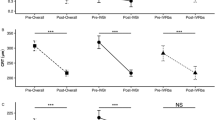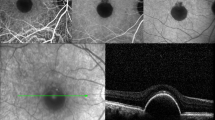Abstract
Background
Fundus autofluorescence (AF) derives from lipofuscin in the retinal pigment epithelium (RPE). Because lipofuscin is a by-product of phagocytosis of photoreceptors by RPE, AF imaging is expected to describe some functional aspect of the retina. In this study we report distribution of AF in patients showing macular edema.
Methods
Three eyes with diabetic macular edema (DME) and 11 with retinal vein occlusion (RVO), associated with macular edema (ME) were examined. ME was determined by standard fundus examination, fluorescein angiography (FA) and optical coherence tomography (OCT). AF was recorded using a Heidelberg confocal scanning laser ophthalmoscope (cSLO) with 488 nm laser exciter (488 nm-AF), and a conventional Topcon fundus camera with halogen lamp exciter and 580 nm band-pass filter (580 nm-AF). Color fundus picture, FA image and these two AF images were analyzed by superimposing all images.
Results
All subjects presented cystoid macular edema (CME) with petaloid pattern hyperfluorescence in FA. In 488 nm-AF, all eyes (100%) showed macular autofluorescence of a similar shape to that of the CME in FA. In contrast, in 580 nm-AF only one eye (7%) presented this corresponding petaloid-shaped autofluorescence. In all cases, peripheral retinal edemas did not show autofluorescence corresponding to the leakage in FA.
Conclusions
In eyes with CME, analogous hyperautofluorescence to the CME was always observed in 488 nm-AF, while it was rarely observed in 580 nm-AF. Moreover, this CME hyperautofluorescence was only seen in the macular area. We hypothesize that autofluorescence from CME may be considered as a “pseudo” or “relative” autofluorescence, due to macular stretching following CME that may result in lateral displacement of macular pigments (MPs) and subsequent reduction of MPs density, as MPs block 488 nm-AF more intensely than 580 nm-AF. Although this phenomenon may not directly indicate change of RPE function, it may be used as a method to assess or track CME non-invasively.


Similar content being viewed by others
References
von Ruckmann A, Fitzke FW, Bird AC (1995) Distribution of fundus autofluorescence with a scanning laser ophthalmoscope. Br J Ophthalmol 79(5):407–412, doi:10.1136/bjo.79.5.407
Lois N, Halfyard AS, Bird AC, Fitzke FW (2000) Quantitative evaluation of fundus autofluorescence imaged “in vivo” in eyes with retinal disease. Br J Ophthalmol 84(7):741–745, doi:10.1136/bjo.84.7.741
Lois N, Halfyard AS, Bunce C, Bird AC, Fitzke FW (1999) Reproducibility of fundus autofluorescence measurements obtained using a confocal scanning laser ophthalmoscope. Br J Ophthalmol 83(3):276–279, doi:10.1136/bjo.83.3.276
Lois N, Owens SL, Coco R, Hopkins J, Fitzke FW, Bird AC (2002) Fundus autofluorescence in patients with age-related macular degeneration and high risk of visual loss. Am J Ophthalmol 133:341–349, doi:10.1016/S0002-9394(01)01404-0
Spaide RF (2003) Fundus autofluorescence and age-related macular degeneration. Ophthalmology 110(2):392–399, doi:10.1016/S0161-6420(02)01756-6
von Ruckmann A, Fitzke FW, Fan J, Halfyard A, Bird AC (2002) Abnormalities of fundus autofluorescence in central serous retinopathy. Am J Ophthalmol 133(6):780–786, doi:10.1016/S0002-9394(02)01428-9
Bessho K, Rodanant N, Bartsch DU, Cheng L, Koh HJ, Freeman WR (2005) Effect of subthreshold infrared laser treatment for drusen regression on macular autofluorescence in patients with age-related macular degeneration. Retina 25(8):981–988, doi:10.1097/00006982-200512000-00005
Solbach U, Keilhauer C, Knabben H, Wolf S (1997) Imaging of retinal autofluorescence in patients with age-related macular degeneration. Retina 17(5):385–389
Gerth C, Andrassi-Darida M, Bock M, Preising MN, Weber BH, Lorenz B (2002) Phenotypes of 16 Stargardt macular dystrophy/fundus flavimaculatus patients with known ABCA4 mutations and evaluation of genotype-phenotype correlation. Graefes Arch Clin Exp Ophthalmol 240(8):628–638, doi:10.1007/s00417-002-0502-y
Framme C, Roider J (2001) Fundus autofluorescence in macular hole surgery. Ophthalmic Surg Lasers 32(5):383–390
Delori FC, Dorey CK, Staurenghi G, Arend O, Goger DG, Weiter JJ (1995) In vivo fluorescence of the ocular fundus exhibits retinal pigment epithelium lipofuscin characteristics. Invest Ophthalmol Vis Sci 36(3):718–729
Delori FC, Fleckner MR, Goger DG, Weiter JJ, Dorey CK (2000) Autofluorescence distribution associated with drusen in age-related macular degeneration. Invest Ophthalmol Vis Sci 41(2):496–504
Delori FC, Goger DG, Dorey CK (2001) Age-related accumulation and spatial distribution of lipofuscin in RPE of normal subjects. Invest Ophthalmol Vis Sci 42(8):1855–1866
Gass JD (1973) Drusen and disciform macular detachment and degeneration. Arch Ophthalmol 90(3):206–217
Katz ML, Robison WG Jr (2002) What is lipofuscin? Defining characteristics and differentiation from other autofluorescent lysosomal storage bodies. Arch Gerontol Geriatr 34(3):169–184, doi:10.1016/S0167-4943(02)00005-5
Bindewald A, Bird AC, Dandekar SS, Dolar-Szczasny J, Dreyhaupt J, Fitzke FW, Einbock W, Holz FG, Jorzik JJ, Keilhauer C, Lois N, Mlynski J, Pauleikhoff D, Staurenghi G, Wolf S (2005) Classification of fundus autofluorescence patterns in early age-related macular disease. Invest Ophthalmol Vis Sci 46(9):3309–3314, doi:10.1167/iovs.04-0430
Framme C, Schule G, Birngruber R, Roider J, Schutt F, Kopitz J, Holz FG, Brinkmann R (2004) Temperature dependent fluorescence of A2-E, the main fluorescent lipofuscin component in the RPE. Curr Eye Res 29(4–5):287–291, doi:10.1080/02713680490516846
Fishkin N, Jang YP, Itagaki Y, Sparrow JR, Nakanishi K (2003) A2-rhodopsin: a new fluorophore isolated from photoreceptor outer segments. Org Biomol Chem 1(7):1101–1105, doi:10.1039/b212213h
Wustemeyer H, Jahn C, Nestler A, Barth T, Wolf S (2002) A new instrument for the quantification of macular pigment density: first results in patients with AMD and healthy subjects. Graefes Arch Clin Exp Ophthalmol 240(8):666–671, doi:10.1007/s00417-002-0515-6
Delori FC, Goger DG, Hammond BR, Snodderly DM, Burns SA (2001) Macular pigment density measured by autofluorescence spectrometry: comparison with reflectometry and heterochromatic flicker photometry. J Opt Soc Am A Opt Image Sci Vis 18(6):1212–1230, doi:10.1364/JOSAA.18.001212
Hammer M, Königsdörffer E, Liebermann C, Framme C, Schuch G, Schweitzer D, Strobel J (2008) Ocular fundus auto-fluorescence observations at different wavelengths in patients with age-related macular degeneration and diabetic retinopathy. Graefes Arch Clin Exp Ophthalmol 246(1):105–114, doi:10.1007/s00417-007-0639-9
Marmorstein AD, Marmorstein LY, Sakaguchi H, Hollyfield JG (2002) Spectral profiling of autofluorescence associated with lipofuscin, Bruch’s Membrane, and sub-RPE deposits in normal and AMD eyes. Invest Ophthalmol Vis Sci 43(7):2435–2441
Bringmann A, Reichenbach A, Wiedemann P (2004) Pathomechanisms of cystoid macular edema. Ophthalmic Res 36(5):241–249, doi:10.1159/000081203
Otani T, Kishi S, Maruyama Y (1999) Patterns of diabetic macular edema with optical coherence tomography. Am J Ophthalmol 127(6):688–693, doi:10.1016/S0002-9394(99)00033-1
McBain VA, Forrester JV, Lois N (2008) Fundus autofluorescence in the diagnosis of cystoid macular oedema. Br J Ophthalmol 92(7):946–949, doi:10.1136/bjo.2007.129957
Author information
Authors and Affiliations
Corresponding author
Additional information
No author has financial relationship for this research.
Kenichiro Bessho and Fumi Gomi have full control of all primary data. The authors agree to allow Graefe’s Archive for Clinical and Experimental Ophthalmology to review their data upon request.
Rights and permissions
About this article
Cite this article
Bessho, K., Gomi, F., Harino, S. et al. Macular autofluorescence in eyes with cystoid macula edema, detected with 488 nm-excitation but not with 580 nm-excitation. Graefes Arch Clin Exp Ophthalmol 247, 729–734 (2009). https://doi.org/10.1007/s00417-008-1033-y
Received:
Revised:
Accepted:
Published:
Issue Date:
DOI: https://doi.org/10.1007/s00417-008-1033-y




